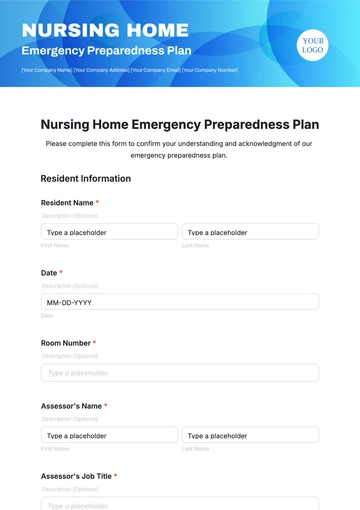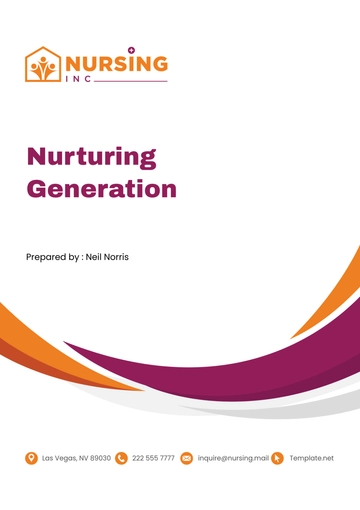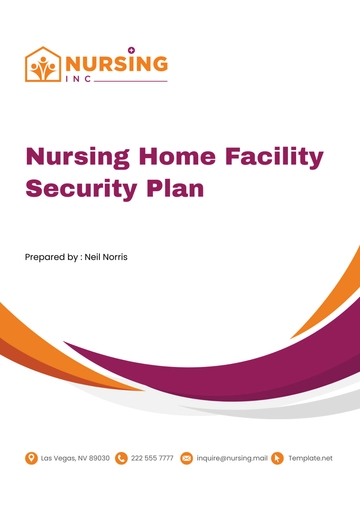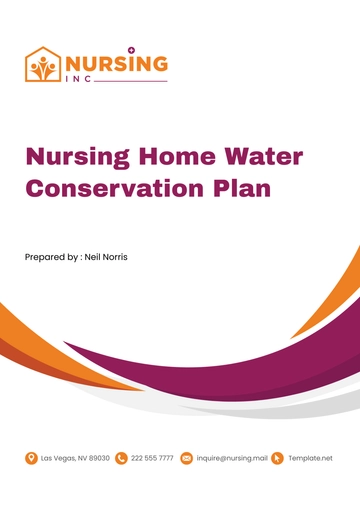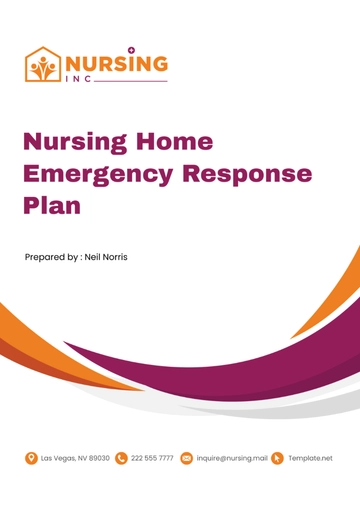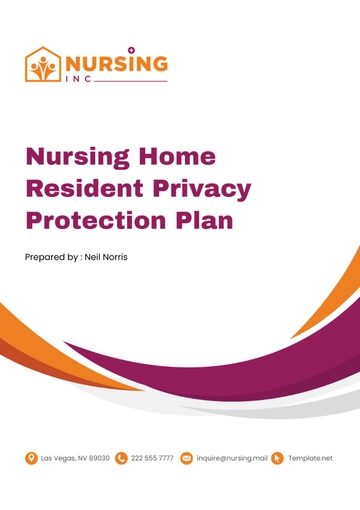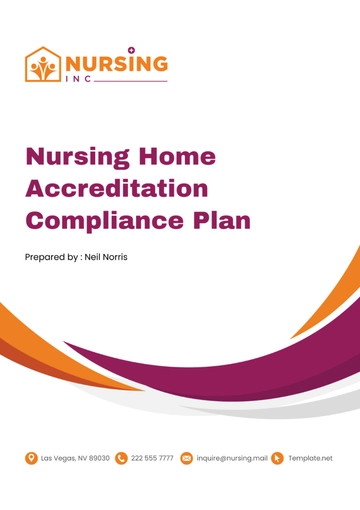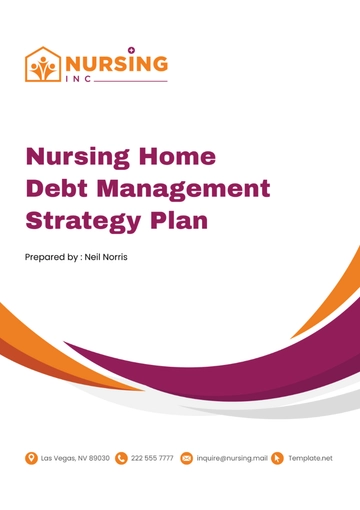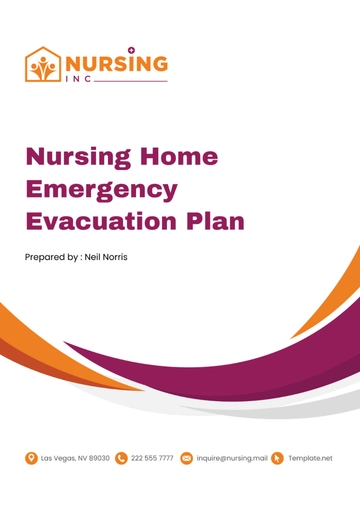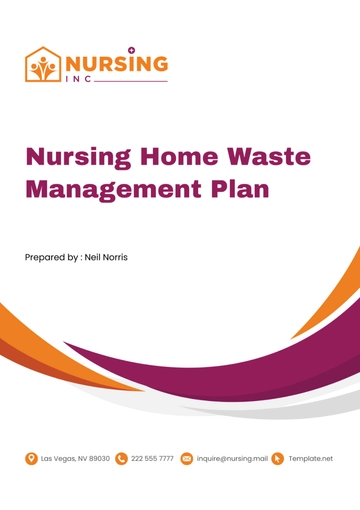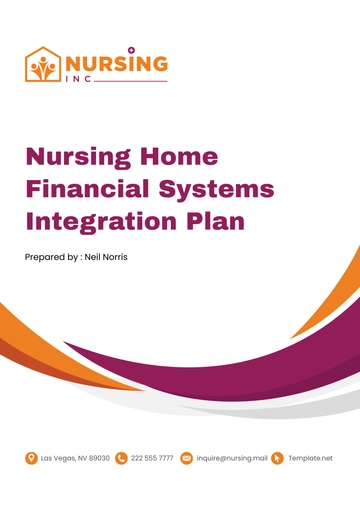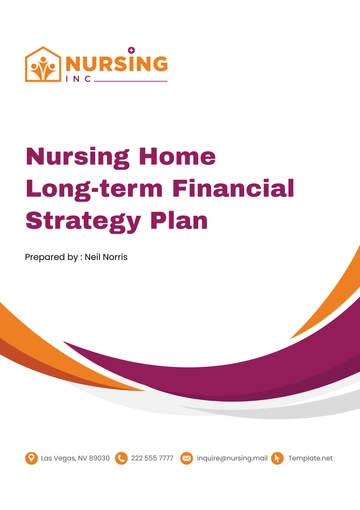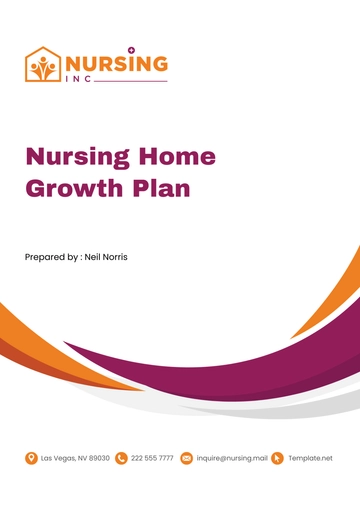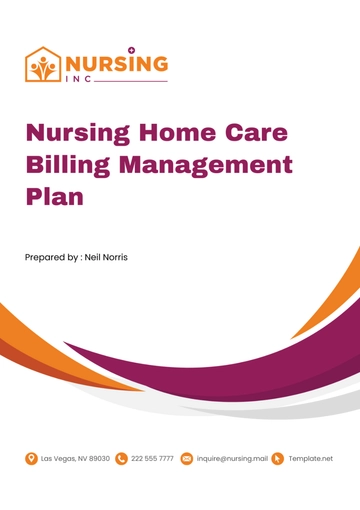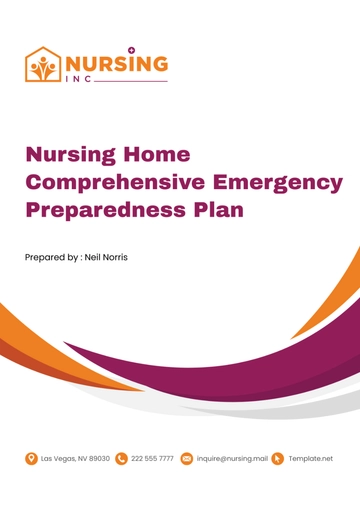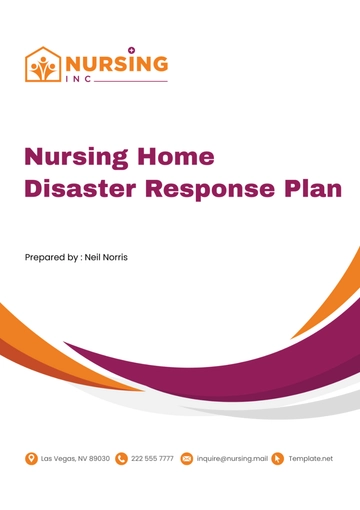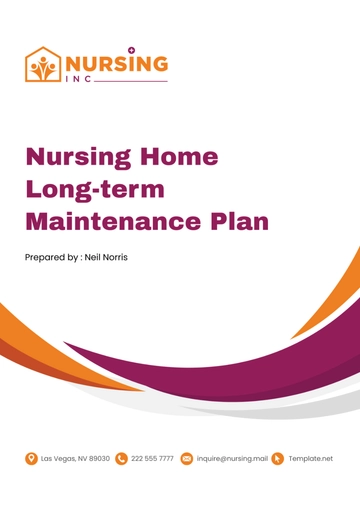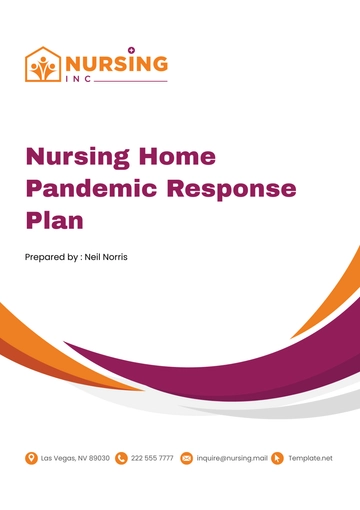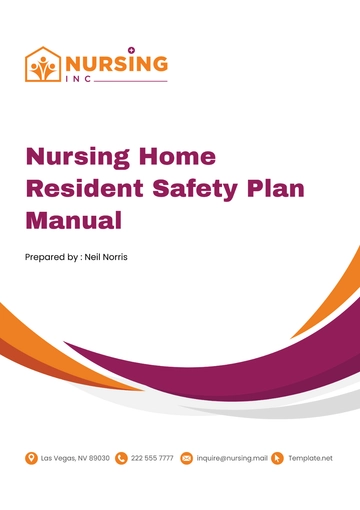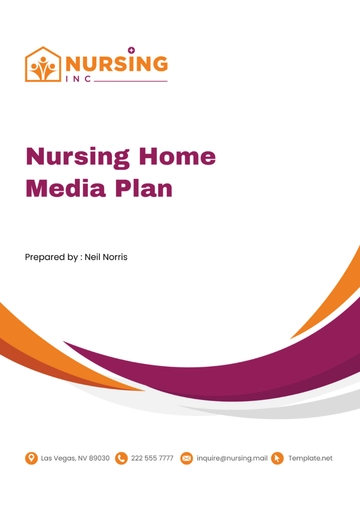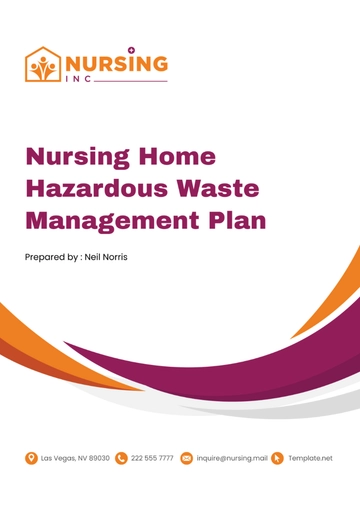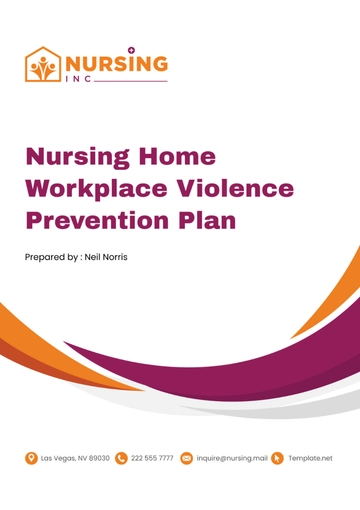Free Nursing Home Growth Plan
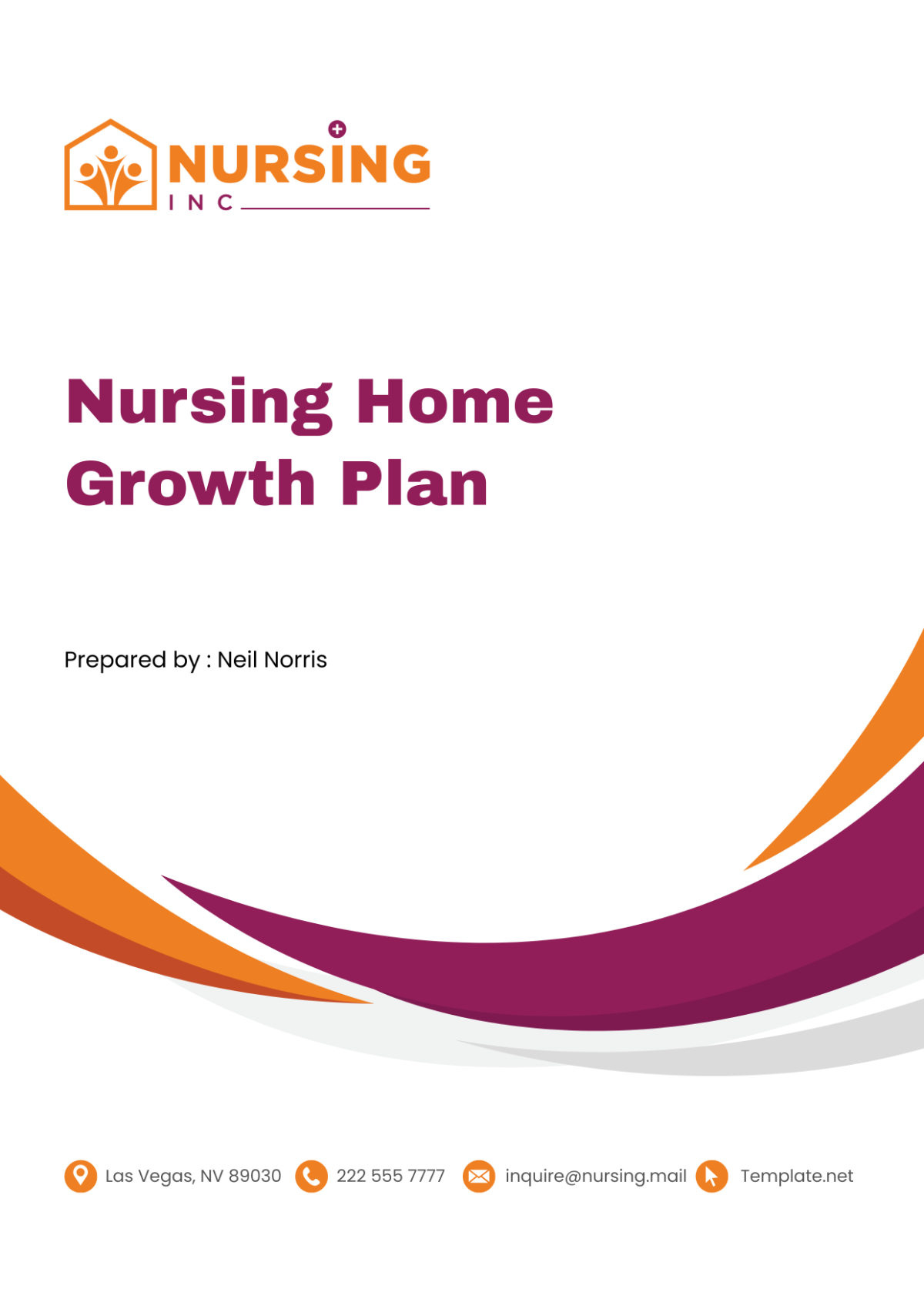
I. Executive Summary
The Nursing Home Growth Plan for [Your Company Name] is a comprehensive strategy designed to expand our network and enhance the quality of our services. The plan focuses on five key areas: infrastructure expansion, staff development, quality services enhancement, operational efficiency, and strategic partnerships. Each of these areas is crucial for our growth and will be addressed in detail in the plan.
Infrastructure expansion involves expanding our physical reach by conducting location surveys, acquiring property, constructing buildings, setting up amenities, and obtaining essential certifications. Staff development on the other hand includes expanding our workforce and providing necessary training.
Moreover, quality services enhancement focuses on improving our current services and adding new ones. Operational efficiency also involves streamlining our operations and implementing a new software system. Additionally, strategic partnerships involve forming partnerships with hospitals, insurance providers, community health programs, pharmaceutical firms, and local transport providers.
The projected timeline for the implementation of our growth plan is two years, and the estimated budget is approximately $15,000,000. This investment will position [Your Company Name] as a leader in the nursing home sector, serving more residents and providing high-quality care.
II. Infrastructure Expansion
Expanding our physical reach is a crucial aspect of our growth strategy. This involves conducting location surveys, acquiring property, constructing buildings, setting up amenities, and obtaining essential certifications.
A. Location Surveys and Demographic Study
Identifying Potential Locations: Potential locations for expansion will be identified based on factors such as population density, demand for nursing home services, and accessibility.
Conducting Demographic Studies: Demographic studies will be conducted in the identified locations. This will help understand the specific needs of the population in these areas.
Finalizing Locations: Based on the results of the surveys and studies, the most suitable locations for our new nursing homes will be finalized.
Planning for Future Expansion: Potential locations for future expansion will also be identified, ensuring that [Your Company Name] continues to grow and serve more communities.
Engaging Local Communities: Engagement with the local communities in the identified locations will be initiated, building relationships and understanding their needs and expectations.
B. Procurement of Property
Property Evaluation: The identified properties will be evaluated, ensuring they meet all our requirements and are within our budget.
Negotiation and Acquisition: Negotiations will be held with the property owners and the properties will be acquired.
Legal Compliance: All property acquisitions will comply with local laws and regulations.
Future Property Management: Plans for the management of the acquired properties, including maintenance and security, will be developed.
C. Construction of Buildings
Designing the Buildings: Architects and designers will be engaged to create building designs that are modern, accessible, and conducive to providing high-quality care.
Construction: Reputable construction companies will be hired to build our nursing homes according to the approved designs.
Quality Assurance: The construction process will be monitored to ensure the buildings are constructed to the highest standards.
Safety Compliance: All necessary safety standards will be adhered to during the construction process to ensure a safe environment for future residents and staff.
III. Staff Development
A. Recruitment Drive
Identifying Staffing Needs: We will first identify our staffing needs based on the size of our expanded network and the services we plan to offer. This will ensure that we have enough staff to provide high-quality care to all our residents.
Job Postings: Once we have identified our staffing needs, we will create job postings that accurately describe the roles, responsibilities, and qualifications for each position. These postings will be advertised on various job search platforms to reach a wide audience.
Candidate Screening: We will screen all applicants to ensure they meet the qualifications for their desired positions. This will involve reviewing resumes, conducting interviews, and checking references.
Hiring: After the screening process, we will select the most qualified candidates for each position and extend job offers to them. We will ensure that our compensation packages are competitive to attract and retain top talent.
Onboarding: Once the candidates have accepted their job offers, we will conduct an onboarding process to familiarize them with our nursing home, our policies, and their roles and responsibilities.
B. Employee Training Programs
Training Needs Assessment: We will conduct a training needs assessment to identify the skills and knowledge our staff need to provide high-quality care. This will involve observing staff, consulting with managers, and getting feedback from residents and their families.
Training Program Development: Based on the results of the training needs assessment, we will develop training programs that address the identified needs. These programs will be designed to be engaging and effective, using a mix of teaching methods to cater to different learning styles.
Training Implementation: We will implement the training programs, ensuring all our staff receive the necessary training. We will also monitor the effectiveness of the training and make adjustments as needed.
Continuous Learning: We will promote a culture of continuous learning in our nursing home. This will involve providing ongoing training opportunities, encouraging staff to pursue further education, and recognizing and rewarding staff who improve their skills and knowledge.
Evaluation: We will regularly evaluate the effectiveness of our training programs. This will involve getting feedback from staff, observing changes in staff performance, and assessing improvements in resident care.
C. Performance Review and Incentives
Performance Review System: We will implement a performance review system to assess the performance of our staff. This will involve setting performance goals, regularly monitoring staff performance, and providing constructive feedback.
Incentive Scheme: We will develop an incentive scheme to reward staff who meet or exceed their performance goals. This will motivate all staff to strive for excellence in their roles.
Promotion Opportunities: We will provide opportunities for staff to advance in their careers. This will involve identifying high-performing staff, providing them with further training and development opportunities, and promoting them to higher positions when they are ready.
Recognition: We will regularly recognize and celebrate the achievements of our staff. This will boost morale and show our staff that their hard work is appreciated.
Work-Life Balance: We will promote a healthy work-life balance for our staff. This will involve ensuring reasonable work hours, providing time off for rest and relaxation, and offering support for staff who are dealing with personal issues.
D. Work Place Safety Measures
Safety Policies: We will develop safety policies to ensure a safe working environment for our staff. These policies will comply with all relevant safety regulations and standards.
Safety Training: We will provide safety training to our staff to ensure they understand and follow our safety policies. This will involve training on topics such as infection control, emergency procedures, and the safe use of equipment.
Safety Audits: We will conduct regular safety audits to identify and address any safety issues. This will involve inspecting our facilities, reviewing our safety records, and consulting with staff about their safety concerns.
Incident Reporting: We will implement a system for reporting and investigating safety incidents. This will help us learn from these incidents and prevent similar incidents in the future.
Continuous Improvement: We will strive for continuous improvement in workplace safety. This will involve regularly reviewing and updating our safety policies, staying informed about new safety research and best practices, and fostering a culture of safety in our nursing home.
E. Staff Health Insurance Packages
Health Insurance Plan: We will develop a comprehensive health insurance plan for our staff. This plan will cover a wide range of health services, ensuring that our staff can access the care they need.
Enrollment: We will enroll our staff in the health insurance plan. We will provide them with information about the plan and assist them with the enrollment process.
Claims Assistance: We will provide assistance with insurance claims. This will involve helping staff understand their insurance coverage, guiding them through the claims process, and advocating for them if any issues arise.
Wellness Programs: We will offer wellness programs as part of our health insurance package. These programs will promote healthy lifestyles and prevent illness, helping to keep our staff healthy and reduce healthcare costs.
Regular Review: We will regularly review our health insurance plan to ensure it continues to meet the needs of our staff. This will involve getting feedback from staff, reviewing our claims data, and staying informed about changes in the health insurance market.
IV. Quality Services Enhancement
A. Investment in Latest Medical Equipment
Identifying Equipment Needs: We will first identify the medical equipment we need to provide high-quality care. This will involve consulting with our medical staff and reviewing the latest research on effective nursing home care.
Purchasing Equipment: Once we have identified our equipment needs, we will purchase the latest medical equipment. We will ensure that all equipment meets safety and quality standards and is user-friendly for our staff.
Training Staff: After the new equipment has been installed, we will train our staff to use it effectively and safely. This will involve hands-on training sessions and ongoing support as staff become familiar with the equipment.
Maintenance and Upgrades: We will schedule regular maintenance for the equipment to ensure it remains in good condition. We will also plan for future upgrades to keep up with advancements in medical technology.
Evaluation: We will regularly evaluate the effectiveness of the equipment in improving resident care. This will involve getting feedback from staff and residents and reviewing health outcomes.
B. Introduction of Specialized Care Services
Identifying Specialized Care Needs: We will identify the specialized care needs of our residents, such as physiotherapy, occupational therapy, and dementia care. This will involve consulting with our medical staff and reviewing the health records of our residents.
Developing Specialized Care Services: Once we have identified the specialized care needs, we will develop services to meet these needs. This will involve hiring or training staff to provide the specialized care and purchasing any necessary equipment or supplies.
Implementing Specialized Care Services: After the specialized care services have been developed, we will implement them in our nursing home. We will ensure that all residents who need specialized care have access to these services.
Evaluation: We will regularly evaluate the effectiveness of the specialized care services. This will involve getting feedback from residents and their families, reviewing health outcomes, and making adjustments as needed.
Continuous Improvement: We will strive for continuous improvement in our specialized care services. This will involve staying informed about the latest research and best practices in specialized care and regularly updating our services to reflect this knowledge.
C. Improvement of Dietary Services
Assessing Dietary Needs: We will assess the dietary needs of our residents, taking into account their health conditions and personal preferences. This will involve consulting with our dietitian and reviewing the health records of our residents.
Developing Dietary Plans: Once we have assessed the dietary needs, we will develop individualized dietary plans for each resident. These plans will ensure that all residents receive nutritious and enjoyable meals that meet their dietary needs.
Training Kitchen Staff: After the dietary plans have been developed, we will train our kitchen staff to prepare the meals according to the plans. This will involve hands-on training sessions and ongoing support as staff learn to prepare a variety of healthy and tasty meals.
Evaluation: We will regularly evaluate the effectiveness of the dietary plans. This will involve getting feedback from residents and their families, reviewing health outcomes, and making adjustments as needed.
Continuous Improvement: We will strive for continuous improvement in our dietary services. This will involve staying informed about the latest research and best practices in nutrition and regularly updating our dietary plans to reflect this knowledge.
V. Operational Efficiency
A. Implementation of Electronic Health Record Systems
Identifying EHR System Needs: We will first identify our needs for an electronic health record (EHR) system. This will involve consulting with our medical and administrative staff and reviewing our current record-keeping practices.
Selecting an EHR System: Once we have identified our needs, we will select an EHR system that meets these needs and is user-friendly for our staff. We will consider factors such as the system’s features, cost, and compatibility with our existing systems.
Implementing the EHR System: After the EHR system has been selected, we will implement it in our nursing home. This will involve installing the system, transferring existing records to the new system, and training staff to use the system.
Ongoing Support: We will provide ongoing support to our staff as they learn to use the EHR system. This will involve providing training resources, answering questions, and troubleshooting any issues that arise.
Evaluation: We will regularly evaluate the effectiveness of the EHR system. This will involve getting feedback from staff, reviewing the accuracy and completeness of our records, and making adjustments as needed.
B. Automated Billing and Payment Systems
Identifying Billing and Payment System Needs: We will identify our needs for an automated billing and payment system. This will involve consulting with our financial and administrative staff and reviewing our current billing and payment processes.
Selecting a Billing and Payment System: Once we have identified our needs, we will select a billing and payment system that meets these needs and is user-friendly for our staff and residents’ families. We will consider factors such as the system’s features, cost, and compatibility with our existing systems.
Implementing the Billing and Payment System: After the billing and payment system has been selected, we will implement it in our nursing home. This will involve installing the system, transferring existing billing and payment data to the new system, and training staff to use the system.
Ongoing Support: We will provide ongoing support to our staff as they learn to use the billing and payment system. This will involve providing training resources, answering questions, and troubleshooting any issues that arise.
Evaluation: We will regularly evaluate the effectiveness of the billing and payment system. This will involve getting feedback from staff and residents’ families, reviewing the accuracy and timeliness of our billing and payments, and making adjustments as needed.
C. Equipment Tracking and Maintenance Schedules
Identifying Equipment Tracking and Maintenance Needs: We will identify our needs for equipment tracking and maintenance. This will involve consulting with our medical and maintenance staff and reviewing our current equipment management practices.
Developing an Equipment Tracking and Maintenance System: Once we have identified our needs, we will develop a system for tracking equipment usage and scheduling maintenance. This will ensure that our equipment is always in good condition and available when needed.
Implementing the Equipment Tracking and Maintenance System: After the system has been developed, we will implement it in our nursing home. This will involve training staff to use the system and setting up a schedule for regular equipment checks and maintenance.
Ongoing Support: We will provide ongoing support to our staff as they learn to use the equipment tracking and maintenance system. This will involve providing training resources, answering questions, and troubleshooting any issues that arise.
Evaluation: We will regularly evaluate the effectiveness of the equipment tracking and maintenance system. This will involve reviewing equipment usage data, maintenance records, and feedback from staff, and making adjustments as needed.
D. Digital Resident Management System
Identifying Resident Management System Needs: We will identify our needs for a digital resident management system. This will involve consulting with our medical and administrative staff and reviewing our current resident management practices.
Selecting a Resident Management System: Once we have identified our needs, we will select a resident management system that meets these needs and is user-friendly for our staff. We will consider factors such as the system’s features, cost, and compatibility with our existing systems.
Implementing the Resident Management System: After the resident management system has been selected, we will implement it in our nursing home. This will involve installing the system, transferring existing resident data to the new system, and training staff to use the system.
Ongoing Support: We will provide ongoing support to our staff as they learn to use the resident management system. This will involve providing training resources, answering questions, and troubleshooting any issues that arise.
Evaluation: We will regularly evaluate the effectiveness of the resident management system. This will involve reviewing resident data, feedback from staff, and the efficiency of our resident management processes, and making adjustments as needed.
E. Data-Driven Decision Making Processes
Identifying Data Analysis Needs: We will identify our needs for data analysis. This will involve consulting with our management team and reviewing our current decision-making processes.
Developing Data Analysis Processes: Once we have identified our needs, we will develop processes for collecting, analyzing, and interpreting data. This will ensure that our decisions are based on accurate and up-to-date information.
Implementing Data Analysis Processes: After the data analysis processes have been developed, we will implement them in our nursing home. This will involve training staff to use the new processes and setting up systems for data collection and analysis.
Ongoing Support: We will provide ongoing support to our staff as they learn to use the data analysis processes. This will involve providing training resources, answering questions, and troubleshooting any issues that arise.
Evaluation: We will regularly evaluate the effectiveness of the data analysis processes. This will involve reviewing the accuracy and completeness of our data, the efficiency of our data analysis, and the impact of data-driven decisions on our operations and resident care.
VI. Strategic Partnerships
A. Partnerships with Hospitals
Identifying Potential Partners: We will identify hospitals in our area that could be potential partners. This will involve researching hospitals, assessing their reputation and services, and considering how a partnership could benefit both parties.
Negotiating Partnerships: Once we have identified potential partners, we will approach them to discuss a possible partnership. This will involve presenting our proposal, discussing the benefits of the partnership, and negotiating the terms of the partnership.
Formalizing Partnerships: After the terms of the partnership have been agreed upon, we will formalize the partnership. This will involve signing a partnership agreement and planning for the implementation of the partnership.
Implementing Partnerships: We will implement the partnership, which may involve coordinating referrals, sharing resources, and collaborating on care for shared residents.
Evaluating Partnerships: We will regularly evaluate the effectiveness of the partnership. This will involve reviewing referral data, getting feedback from staff and residents, and assessing the impact of the partnership on our operations and resident care.
B. Tie-ups with Insurance Providers
Identifying Potential Providers: We will identify insurance providers that could be potential partners. This will involve researching providers, assessing their reputation and services, and considering how a partnership could benefit both parties.
Negotiating Tie-ups: Once we have identified potential providers, we will approach them to discuss a possible tie-up. This will involve presenting our proposal, discussing the benefits of the tie-up, and negotiating the terms of the tie-up.
Formalizing Tie-ups: After the terms of the tie-up have been agreed upon, we will formalize the tie-up. This will involve signing a tie-up agreement and planning for the implementation of the tie-up.
Implementing Tie-ups: We will implement the tie-up, which may involve coordinating billing and payments, sharing information, and collaborating on care for shared residents.
Evaluating Tie-ups: We will regularly evaluate the effectiveness of the tie-up. This will involve reviewing billing and payment data, getting feedback from staff and residents, and assessing the impact of the tie-up on our operations and resident care.
C. Collaborations with Community Health Programs
Identifying Potential Programs: We will identify community health programs that could be potential partners. This will involve researching programs, assessing their reputation and services, and considering how a collaboration could benefit both parties.
Negotiating Collaborations: Once we have identified potential programs, we will approach them to discuss a possible collaboration. This will involve presenting our proposal, discussing the benefits of the collaboration, and negotiating the terms of the collaboration.
Formalizing Collaborations: After the terms of the collaboration have been agreed upon, we will formalize the collaboration. This will involve signing a collaboration agreement and planning for the implementation of the collaboration.
Implementing Collaborations: We will implement the collaboration, which may involve coordinating services, sharing resources, and collaborating on care for shared residents.
Evaluating Collaborations: We will regularly evaluate the effectiveness of the collaboration. This will involve reviewing service data, getting feedback from staff and residents, and assessing the impact of the collaboration on our operations and resident care.
D. Partnership with Pharmaceutical Firms
Identifying Potential Firms: We will identify pharmaceutical firms that could be potential partners. This will involve researching firms, assessing their reputation and products, and considering how a partnership could benefit both parties.
Negotiating Partnerships: Once we have identified potential firms, we will approach them to discuss a possible partnership. This will involve presenting our proposal, discussing the benefits of the partnership, and negotiating the terms of the partnership.
Formalizing Partnerships: After the terms of the partnership have been agreed upon, we will formalize the partnership. This will involve signing a partnership agreement and planning for the implementation of the partnership.
Implementing Partnerships: We will implement the partnership, which may involve coordinating medication orders and deliveries, sharing information, and collaborating on care for shared residents.
Evaluating Partnerships: We will regularly evaluate the effectiveness of the partnership. This will involve reviewing medication data, getting feedback from staff and residents, and assessing the impact of the partnership on our operations and resident care.
E. Alliances with Local Transport Providers
Identifying Potential Providers: We will identify local transport providers that could be potential partners. This will involve researching providers, assessing their reputation and services, and considering how an alliance could benefit both parties.
Negotiating Alliances: Once we have identified potential providers, we will approach them to discuss a possible alliance. This will involve presenting our proposal, discussing the benefits of the alliance, and negotiating the terms of the alliance.
Formalizing Alliances: After the terms of the alliance have been agreed upon, we will formalize the alliance. This will involve signing an alliance agreement and planning for the implementation of the alliance.
Implementing Alliances: We will implement the alliance, which may involve coordinating transport services for our residents, sharing information, and collaborating on care for shared residents.
Evaluating Alliances: We will regularly evaluate the effectiveness of the alliance. This will involve reviewing transport data, getting feedback from staff and residents, and assessing the impact of the alliance on our operations and resident care.
VII. Timeline
The timeline of our growth plan is a crucial aspect of our strategy. The following table outlines the timeline for each phase of our growth plan:
Phase | Duration |
|---|---|
Infrastructure Expansion | 12 months |
Staff Development | 8 months |
Quality Services Enhancement | 6 months |
Operational Efficiency | 6 months |
Strategic Partnerships | 4 months |
A. Infrastructure Expansion
The infrastructure expansion phase, which is expected to last 12 months, involves expanding our physical reach. This phase is the longest as it involves several complex tasks, including property acquisition and construction.
B. Staff Development
The staff development phase is expected to take 8 months. During this phase, we will expand our workforce and provide necessary training. This includes conducting a recruitment drive, implementing employee training programs, and reviewing performance and incentives.
C. Quality Services Enhancement
The quality services enhancement phase is expected to last 6 months. In this phase, we will focus on improving our current services and adding new ones. This includes investing in the latest medical equipment, and introducing specialized care services.
D. Operational Efficiency
The operational efficiency phase, also expected to last 6 months, involves streamlining our operations. We will implement a new software system to increase efficiency and reduce errors.
E. Strategic Partnerships
The strategic partnerships phase is expected to take 4 months. During this phase, we will form partnerships that will help us create a supportive healthcare network, ensure a steady influx of residents, and enhance our services.
This timeline underscores the importance of careful planning and coordination in implementing our growth plan. Each phase of the plan is interconnected, with the success of one phase impacting the success of the next. By adhering to the timeline, we can ensure that all aspects of our growth plan are aligned and that we are moving towards our growth objectives in a coordinated manner.
VIII. Budget
The budget for our growth plan is an essential part of our strategy. The following chart and table outline the budget for each phase of our growth plan:
Area | Estimated Cost |
|---|---|
Infrastructure Expansion | $8,000,000 |
Staff Development | $2,000,000 |
Quality Services Enhancement | $2,000,000 |
Operational Efficiency | $1,000,000 |
Strategic Partnerships | $2,000,000 |
Total | $15,000,000 |
A. Infrastructure Expansion
The infrastructure expansion phase has the highest estimated cost at $8,000,000. This is due to the significant expenses associated with acquiring property, constructing buildings, setting up amenities, and obtaining essential certifications. Despite the high cost, this phase is crucial for expanding our physical reach and serving more residents.
B. Staff Development
The staff development phase has an estimated cost of $2,000,000. This cost will cover the recruitment of new staff, implementation of training programs, performance reviews and incentives, workplace safety measures, and staff health insurance packages. Investing in our staff is essential for providing high-quality care to our residents.
C. Quality Services Enhancement
The quality services enhancement phase also has an estimated cost of $2,000,000. This cost will cover the purchase of the latest medical equipment, introduction of specialized care services, improvement of dietary services, implementation of mental health programs, and setup of physical rehabilitation programs. Enhancing the quality of our services is crucial for increasing resident satisfaction and retention.
D. Operational Efficiency
The operational efficiency phase has an estimated cost of $1,000,000. This cost will cover the implementation of electronic health record systems, automated billing and payment systems, equipment tracking and maintenance schedules, a digital resident management system, and data-driven decision-making processes. Improving operational efficiency will increase our productivity and reduce costs.
E. Strategic Partnerships
The strategic partnerships phase has an estimated cost of $2,000,000. This cost will cover the formation of partnerships with hospitals, tie-ups with insurance providers, collaborations with community health programs, partnerships with pharmaceutical firms, and alliances with local transport providers. Forming strategic partnerships will help us create a supportive healthcare network, ensure a steady influx of residents, and enhance our services.
The budget provides a clear breakdown of the estimated costs for each phase of our growth plan. By adhering to this budget, we can ensure that we have the necessary funds to carry out all tasks and achieve our growth objectives.
Moreover, the budget underscores the importance of careful financial planning in implementing our growth plan. Each phase of the plan requires significant investment, and we must ensure that we have the necessary funds to cover these costs. By adhering to the budget, we can ensure that our growth plan is financially viable and that we are investing our resources wisely.
IX. Risks and Mitigation
Every growth strategy comes with risks. Identifying them and preparing mitigation strategies aligns us with the desired growth trajectory.
A. Financial Risk
Risk Identification: Financial risk is a significant concern in any growth plan. This could include potential cost overruns, lower than expected revenue growth, or unexpected financial losses.
Risk Mitigation: We will mitigate financial risk by maintaining a robust financial management system, regularly reviewing our financial performance, and adjusting our strategies as needed. We will also maintain a contingency fund to cover unexpected costs or losses.
Risk Monitoring: We will regularly monitor our financial risk by tracking key financial indicators, conducting financial audits, and staying informed about economic trends and changes in the healthcare industry.
B. Operational Risk
Risk Identification: Operational risk includes risks related to our day-to-day operations, such as staff turnover, equipment failure, or disruptions in our supply chain.
Risk Mitigation: We will mitigate operational risk by maintaining high standards in our operations, providing regular training and support to our staff, and establishing strong relationships with our suppliers. We will also develop contingency plans to manage disruptions in our operations.
Risk Monitoring: We will regularly monitor our operational risk by tracking key operational indicators, conducting operational audits, and getting feedback from our staff and residents.
C. Regulatory Risk
Risk Identification: Regulatory risk involves potential changes in healthcare regulations or non-compliance with existing regulations.
Risk Mitigation: We will mitigate regulatory risk by staying informed about changes in healthcare regulations, ensuring compliance with all regulations in our operations, and advocating for favorable policies in the healthcare industry.
Risk Monitoring: We will regularly monitor our regulatory risk by tracking changes in healthcare regulations, conducting compliance audits, and engaging with regulatory bodies and industry associations.
D. Market Risk
Risk Identification: Market risk includes risks related to changes in the healthcare market, such as increased competition, changes in demand for nursing home services, or changes in healthcare funding.
Risk Mitigation: We will mitigate market risk by staying informed about changes in the healthcare market, regularly reviewing our market strategy, and adapting our services to meet changing market needs.
Risk Monitoring: We will regularly monitor our market risk by tracking changes in the healthcare market, conducting market research, and getting feedback from our residents and their families.
E. Reputational Risk
Risk Identification: Reputational risk involves potential damage to our reputation, which could affect our relationships with residents, their families, our staff, and the wider community.
Risk Mitigation: We will mitigate reputational risk by maintaining high standards in our care and services, effectively managing complaints and negative feedback, and promoting our achievements and positive impact.
Risk Monitoring: We will regularly monitor our reputational risk by tracking public sentiment about our nursing home, managing our online presence, and getting feedback from our residents, their families, and our staff.
X. Conclusion
In conclusion, the growth plan provides a clear and detailed roadmap for our expansion. By adhering to this plan and adapting as required, we can anticipate a substantial growth in our services, capabilities, and client base. Regular assessments and reviews will be crucial in tracking our progress and making necessary adjustments. This commitment to continuous improvement will ensure that [Your Company Name] remains a leading provider in the nursing home sector.
Our dedicated staff, modern facilities, and commitment to quality care are the foundation of our success. As we move forward, we will continue to focus on enhancing our value proposition, improving our services, and ensuring the satisfaction and well-being of our residents. We believe that with these efforts, [Your Company Name] will continue to grow and succeed in the years to come.
- 100% Customizable, free editor
- Access 1 Million+ Templates, photo’s & graphics
- Download or share as a template
- Click and replace photos, graphics, text, backgrounds
- Resize, crop, AI write & more
- Access advanced editor
Foster growth and development effortlessly with this customizable Nursing Home Growth Plan Template provided by Template.net! Utilize the AI Editor Tool to customize the growth plan to align with organizational goals and objectives effectively. With customizable features, the growth plan can be tailored to address specific growth opportunities and challenges!
You may also like
- Finance Plan
- Construction Plan
- Sales Plan
- Development Plan
- Career Plan
- Budget Plan
- HR Plan
- Education Plan
- Transition Plan
- Work Plan
- Training Plan
- Communication Plan
- Operation Plan
- Health And Safety Plan
- Strategy Plan
- Professional Development Plan
- Advertising Plan
- Risk Management Plan
- Restaurant Plan
- School Plan
- Nursing Home Patient Care Plan
- Nursing Care Plan
- Plan Event
- Startup Plan
- Social Media Plan
- Staffing Plan
- Annual Plan
- Content Plan
- Payment Plan
- Implementation Plan
- Hotel Plan
- Workout Plan
- Accounting Plan
- Campaign Plan
- Essay Plan
- 30 60 90 Day Plan
- Research Plan
- Recruitment Plan
- 90 Day Plan
- Quarterly Plan
- Emergency Plan
- 5 Year Plan
- Gym Plan
- Personal Plan
- IT and Software Plan
- Treatment Plan
- Real Estate Plan
- Law Firm Plan
- Healthcare Plan
- Improvement Plan
- Media Plan
- 5 Year Business Plan
- Learning Plan
- Marketing Campaign Plan
- Travel Agency Plan
- Cleaning Services Plan
- Interior Design Plan
- Performance Plan
- PR Plan
- Birth Plan
- Life Plan
- SEO Plan
- Disaster Recovery Plan
- Continuity Plan
- Launch Plan
- Legal Plan
- Behavior Plan
- Performance Improvement Plan
- Salon Plan
- Security Plan
- Security Management Plan
- Employee Development Plan
- Quality Plan
- Service Improvement Plan
- Growth Plan
- Incident Response Plan
- Basketball Plan
- Emergency Action Plan
- Product Launch Plan
- Spa Plan
- Employee Training Plan
- Data Analysis Plan
- Employee Action Plan
- Territory Plan
- Audit Plan
- Classroom Plan
- Activity Plan
- Parenting Plan
- Care Plan
- Project Execution Plan
- Exercise Plan
- Internship Plan
- Software Development Plan
- Continuous Improvement Plan
- Leave Plan
- 90 Day Sales Plan
- Advertising Agency Plan
- Employee Transition Plan
- Smart Action Plan
- Workplace Safety Plan
- Behavior Change Plan
- Contingency Plan
- Continuity of Operations Plan
- Health Plan
- Quality Control Plan
- Self Plan
- Sports Development Plan
- Change Management Plan
- Ecommerce Plan
- Personal Financial Plan
- Process Improvement Plan
- 30-60-90 Day Sales Plan
- Crisis Management Plan
- Engagement Plan
- Execution Plan
- Pandemic Plan
- Quality Assurance Plan
- Service Continuity Plan
- Agile Project Plan
- Fundraising Plan
- Job Transition Plan
- Asset Maintenance Plan
- Maintenance Plan
- Software Test Plan
- Staff Training and Development Plan
- 3 Year Plan
- Brand Activation Plan
- Release Plan
- Resource Plan
- Risk Mitigation Plan
- Teacher Plan
- 30 60 90 Day Plan for New Manager
- Food Safety Plan
- Food Truck Plan
- Hiring Plan
- Quality Management Plan
- Wellness Plan
- Behavior Intervention Plan
- Bonus Plan
- Investment Plan
- Maternity Leave Plan
- Pandemic Response Plan
- Succession Planning
- Coaching Plan
- Configuration Management Plan
- Remote Work Plan
- Self Care Plan
- Teaching Plan
- 100-Day Plan
- HACCP Plan
- Student Plan
- Sustainability Plan
- 30 60 90 Day Plan for Interview
- Access Plan
- Site Specific Safety Plan
